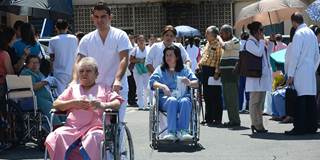Since the 1990s, one of Latin America’s smallest countries has built a system of primary health care that reaches nearly every citizen. Four key reforms underpinned this progress, and offer a model that other countries pursuing universal health coverage should consider.
BOSTON – Two years after the death of her husband, Valeria, a 67-year-old grandmother in San José, Costa Rica, lives alone. Last year, she was diagnosed with high blood pressure and diabetes, conditions that, while not immediately life threatening, require health care to manage. But, thanks to the quality of Costa Rica’s primary health-care system, Valeria has been able to maintain her independence and her health, even in the absence of family.

BOSTON – Two years after the death of her husband, Valeria, a 67-year-old grandmother in San José, Costa Rica, lives alone. Last year, she was diagnosed with high blood pressure and diabetes, conditions that, while not immediately life threatening, require health care to manage. But, thanks to the quality of Costa Rica’s primary health-care system, Valeria has been able to maintain her independence and her health, even in the absence of family.